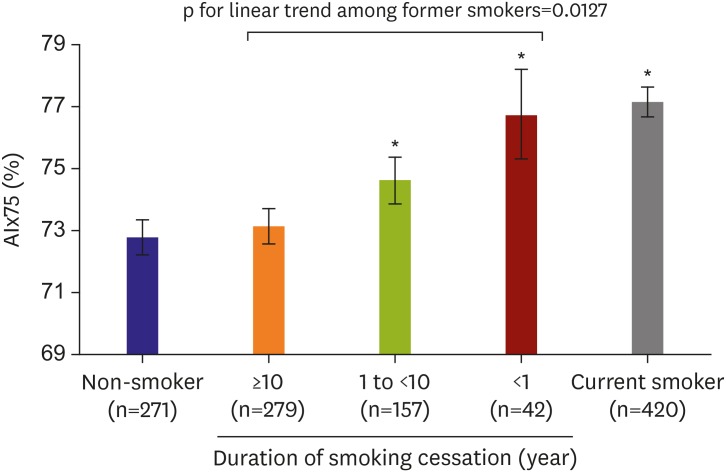1. Ng M, Freeman MK, Fleming TD, et al. Smoking prevalence and cigarette consumption in 187 countries, 1980–2012. JAMA. 2014; 311:183–192. PMID:
24399557.
2. Ambrose JA, Barua RS. The pathophysiology of cigarette smoking and cardiovascular disease: an update. J Am Coll Cardiol. 2004; 43:1731–1737. PMID:
15145091.
3. McGill HC Jr. The cardiovascular pathology of smoking. Am Heart J. 1988; 115:250–257. PMID:
3276113.
4. Tanaka H, Safar ME. Influence of lifestyle modification on arterial stiffness and wave reflections. Am J Hypertens. 2005; 18:137–144. PMID:
15691628.
5. Rehill N, Beck CR, Yeo KR, Yeo WW. The effect of chronic tobacco smoking on arterial stiffness. Br J Clin Pharmacol. 2006; 61:767–773. PMID:
16722843.
6. Wei YJ, Liu HL, Liu B, Zhang L, Jin ZG. Impact of smoking and smoking cessation on arterial stiffness in healthy participants. Angiology. 2013; 64:273–280. PMID:
22649109.
7. van den Berkmortel FW, Wollersheim H, van Langen H, Smilde TJ, den Arend J, Thien T. Two years of smoking cessation does not reduce arterial wall thickness and stiffness. Neth J Med. 2004; 62:235–241. PMID:
15554598.
8. Shim JS, Song BM, Lee JH, et al. Cardiovascular and Metabolic Diseases Etiology Research Center (CMERC) cohort: study protocol and results of the first 3 years of enrollment. Epidemiol Health. 2017; 39:e2017016. PMID:
28395401.
9. Chun MY. Validity and reliability of Korean version of international physical activity questionnaire short form in the elderly. Korean J Fam Med. 2012; 33:144–151. PMID:
22787536.
10. Kohara K, Tabara Y, Oshiumi A, Miyawaki Y, Kobayashi T, Miki T. Radial augmentation index: a useful and easily obtainable parameter for vascular aging. Am J Hypertens. 2005; 18:11S–14S. PMID:
15683726.
11. Jatoi NA, Jerrard-Dunne P, Feely J, Mahmud A. Impact of smoking and smoking cessation on arterial stiffness and aortic wave reflection in hypertension. Hypertension. 2007; 49:981–985. PMID:
17372029.
12. Middlekauff HR, Park J, Moheimani RS. Adverse effects of cigarette and noncigarette smoke exposure on the autonomic nervous system: mechanisms and implications for cardiovascular risk. J Am Coll Cardiol. 2014; 64:1740–1750. PMID:
25323263.
13. Sun Z. Aging, arterial stiffness, and hypertension. Hypertension. 2015; 65:252–256. PMID:
25368028.
14. Oren S, Isakov I, Golzman B, et al. The influence of smoking cessation on hemodynamics and arterial compliance. Angiology. 2006; 57:564–568. PMID:
17067978.
15. Minami J, Ishimitsu T, Matsuoka H. Effects of smoking cessation on blood pressure and heart rate variability in habitual smokers. Hypertension. 1999; 33:586–590. PMID:
9931170.
16. Yotsukura M, Koide Y, Fujii K, et al. Heart rate variability during the first month of smoking cessation. Am Heart J. 1998; 135:1004–1009. PMID:
9630104.
17. Middlekauff HR, Park J, Agrawal H, Gornbein JA. Abnormal sympathetic nerve activity in women exposed to cigarette smoke: a potential mechanism to explain increased cardiac risk. Am J Physiol Heart Circ Physiol. 2013; 305:H1560–7. PMID:
23997107.
18. Scherrer U, Sartori C. Defective nitric oxide synthesis: a link between metabolic insulin resistance, sympathetic overactivity and cardiovascular morbidity. Eur J Endocrinol. 2000; 142:315–323. PMID:
10754469.
19. Haynes WG, Noon JP, Walker BR, Webb DJ. Inhibition of nitric oxide synthesis increases blood pressure in healthy humans. J Hypertens. 1993; 11:1375–1380. PMID:
7510736.
20. Sartori C, Lepori M, Scherrer U. Interaction between nitric oxide and the cholinergic and sympathetic nervous system in cardiovascular control in humans. Pharmacol Ther. 2005; 106:209–220. PMID:
15866320.
21. Node K, Kitakaze M, Yoshikawa H, Kosaka H, Hori M. Reversible reduction in plasma concentration of nitric oxide induced by cigarette smoking in young adults. Am J Cardiol. 1997; 79:1538–1541. PMID:
9185651.
22. Zhou JF, Yan XF, Guo FZ, Sun NY, Qian ZJ, Ding DY. Effects of cigarette smoking and smoking cessation on plasma constituents and enzyme activities related to oxidative stress. Biomed Environ Sci. 2000; 13:44–55. PMID:
10853840.
23. Sakuma I, Togashi H, Yoshioka M, et al. NG-methyl-L-arginine, an inhibitor of L-arginine-derived nitric oxide synthesis, stimulates renal sympathetic nerve activity in vivo. A role for nitric oxide in the central regulation of sympathetic tone? Circ Res. 1992; 70:607–611. PMID:
1537096.
24. Chowdhary S, Vaile JC, Fletcher J, Ross HF, Coote JH, Townend JN. Nitric oxide and cardiac autonomic control in humans. Hypertension. 2000; 36:264–269. PMID:
10948088.
25. Balligand JL, Kelly RA, Marsden PA, Smith TW, Michel T. Control of cardiac muscle cell function by an endogenous nitric oxide signaling system. Proc Natl Acad Sci U S A. 1993; 90:347–351. PMID:
7678347.
26. Howard G, Wagenknecht LE, Burke GL, et al. Cigarette smoking and progression of atherosclerosis: The Atherosclerosis Risk in Communities (ARIC) Study. JAMA. 1998; 279:119–124. PMID:
9440661.
27. Cheng LT, Tang LJ, Cheng L, Huang HY, Wang T. Limitation of the augmentation index for evaluating arterial stiffness. Hypertens Res. 2007; 30:713–722. PMID:
17917319.
28. Wagenknecht LE, Burke GL, Perkins LL, Haley NJ, Friedman GD. Misclassification of smoking status in the CARDIA study: a comparison of self-report with serum cotinine levels. Am J Public Health. 1992; 82:33–36. PMID:
1536331.
29. Vartiainen E, Seppälä T, Lillsunde P, Puska P. Validation of self reported smoking by serum cotinine measurement in a community-based study. J Epidemiol Community Health. 2002; 56:167–170. PMID:
11854334.







 PDF
PDF ePub
ePub Citation
Citation Print
Print



 XML Download
XML Download